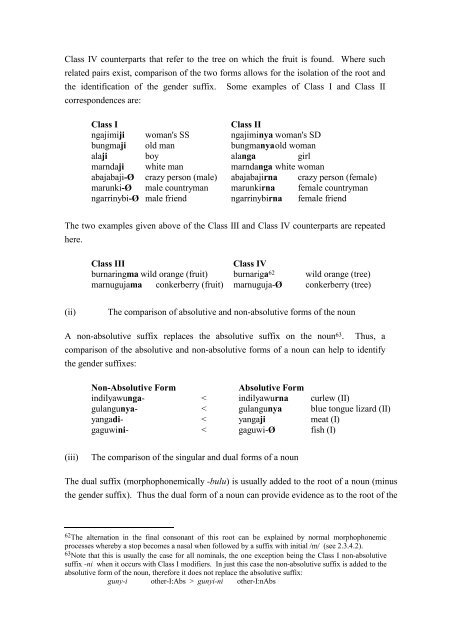- Page 1 and 2:
A GRAMMAR OF WAMBAYA by RACHEL NORD
- Page 3 and 4:
3.1.2 Non-inflecting word classes 6
- Page 5 and 6:
7.1.4 Possessive clauses 205 7.1.5
- Page 7 and 8:
Acknowledgements Although there are
- Page 9 and 10:
Preface The research for this thesi
- Page 11 and 12:
Fut G GEN H Hab IMP inc INCH INF IN
- Page 13 and 14:
Chapter One THE LANGUAGE and ITS SP
- Page 15 and 16:
1.1.1 The West Barkly languages The
- Page 17 and 18:
1.1.2. Wider relationships As they
- Page 19 and 20:
absolutive gender affixes which app
- Page 21 and 22:
The Yumpia (Umbaia) lives in countr
- Page 23 and 24:
mostly Gudanji with a bit of Wambay
- Page 25 and 26:
Figure 1.1 Wambaya Subsections (fro
- Page 27 and 28:
mother and his third choice is some
- Page 29 and 30:
The Wambaya kinship terms are given
- Page 31 and 32:
Table 1.8 Kinship terms - female eg
- Page 33 and 34:
(i) The homorganic nasal-stop clust
- Page 35 and 36:
Chadwick (1978:15) also recorded bi
- Page 37 and 38:
that /rr/ and /d/ only contrast in
- Page 39 and 40:
garnmangga 'jaw' l/rl bulinja 'alga
- Page 41 and 42:
mimayirna/ 'mother-in-law' > [·mÈ
- Page 43 and 44:
(v) CVCC eg. lurrg.ba.nyi 'grab, sn
- Page 45 and 46: There is no contrast between [wø]
- Page 47 and 48: Other dialect Wambaya Gloss (I) wal
- Page 49 and 50: jurlurrburra 'ashes' rrm darrmanji
- Page 51 and 52: These seven principles account for
- Page 53 and 54: ·garn.gu. + ji many + I:Abs > ·ga
- Page 55 and 56: Following are some sample derivatio
- Page 57 and 58: ∑ ∑ ∑ The feet that have been
- Page 59 and 60: 2.3.1 Lenition The initial /b/ of a
- Page 61 and 62: 2.3.4.1 /w/ > /y/ An intervocalic /
- Page 63 and 64: Nor does it affect the vowel(s) of
- Page 65 and 66: There are two examples in which a c
- Page 67 and 68: iii. σ + σ σ banymi (b)any mi iv
- Page 69 and 70: Chapter 3 PARTS OF SPEECH and OTHER
- Page 71 and 72: Class IV (the neuter gender) is gen
- Page 73 and 74: actually verbs, and not simply othe
- Page 75 and 76: Temporal nominals provide temporal
- Page 77 and 78: The following examples demonstrate
- Page 79 and 80: and 'still'. It is a restricted cli
- Page 81 and 82: more closely linked with specific s
- Page 83 and 84: (3-28) Yabu gama gujiga-nmanji mang
- Page 85 and 86: Chapter 4 NOMINALS 4.1 THE STRUCTUR
- Page 87 and 88: Nouns in Wambaya are divided into f
- Page 89 and 90: As (iii) suggests, for some non-hum
- Page 91 and 92: manganyma burnaringma jigama ngaman
- Page 93 and 94: gulangunya/milirrgbarna 'blue tongu
- Page 95: Table 4.3 Gender marking in Wambaya
- Page 99 and 100: assimilation of the nasal to the pl
- Page 101 and 102: Examples are bungmaji and abajabaji
- Page 103 and 104: cousin Absolutive form Non-absoluti
- Page 105 and 106: maga-wulu iligirra-wulu camp-DUAL r
- Page 107 and 108: agreeing with the inanimate semanti
- Page 109 and 110: Wambaya formally distinguishes thre
- Page 111 and 112: e generated with the use of the reg
- Page 113 and 114: or the nominal can have dual markin
- Page 115 and 116: (4-40) Gagulu-marndi y.brother-PLUR
- Page 117 and 118: As mentioned above, the most common
- Page 119 and 120: In Jingili rdarra is a free form th
- Page 121 and 122: old.woman:II:Abs-NOM 3sgS-Pst wait(
- Page 123 and 124: (4-61) Ngabulu-nu ngiyi-ng-agba daw
- Page 125 and 126: I'm going to spear you with a spear
- Page 127 and 128: The dative case is used in a large
- Page 129 and 130: You'll come back for money. The dat
- Page 131 and 132: The dative suffix can be used to ma
- Page 133 and 134: PERL tears:IV(NOM) 3sgS(Pres)-Pr ru
- Page 135 and 136: I'm sitting on the boy's bed. More
- Page 137 and 138: Sand-having (IV). For some nouns ei
- Page 139 and 140: One might expect that this differen
- Page 141 and 142: (4-165) janji-yaji dog:I:Abs-PRIV:I
- Page 143 and 144: care.for(nF) 3sgnmascA(Pres) talk-P
- Page 145 and 146: (4-186) Guyalinja darranggu-nka. la
- Page 147 and 148:
Unfortunately there are not enough
- Page 149 and 150:
The "cheeky" man hit me. (4-194) Ay
- Page 151 and 152:
they modify in terms of gender, num
- Page 153 and 154:
postposed demonstratives (see Appen
- Page 155 and 156:
Number Singular: {-Ø} Dual: {-wulu
- Page 157 and 158:
B rnana ngankiwa nganaga Ng arna, a
- Page 159 and 160:
The remote singular forms in the ot
- Page 161 and 162:
(4-200) Mirrang-ba ng-u ngankagunya
- Page 163 and 164:
In this function, the difference be
- Page 165 and 166:
du nagawuliji pl Class IV NOM/ACC s
- Page 167 and 168:
fact that they can modify a head no
- Page 169 and 170:
With what will hit (him)? (4-223) G
- Page 171 and 172:
This ignorative can be combined wit
- Page 173 and 174:
what:I:nAbs-LOC 3sgmascA-Pst pull(n
- Page 175 and 176:
The non-singular accusative/oblique
- Page 177 and 178:
number and case with the noun that
- Page 179 and 180:
suffix (4.4.1.4), have all involved
- Page 181 and 182:
for its existence as a constituent.
- Page 183 and 184:
I'll go. Pro (Obl) (4-276) Yandu ng
- Page 185 and 186:
As mentioned above, the constructio
- Page 187 and 188:
Chapter Five THE AUXILIARY The auxi
- Page 189 and 190:
I therefore disagree with Blake's c
- Page 191 and 192:
When the object is third person non
- Page 193 and 194:
(5-23) Alag-bulu wurlu-ngg-a nyurru
- Page 195 and 196:
tense, aspect and mood information
- Page 197 and 198:
(b) Ngara-bi ngurru-Ø. drink-nF 1p
- Page 199 and 200:
I will always be thinking about you
- Page 201 and 202:
is singular (5-46, 5-47, 5-48). The
- Page 203 and 204:
PAST NON-PAST TOWARDS -amany -ulama
- Page 205 and 206:
(5-68) Gannga g-a ngurraramba-ni. r
- Page 207 and 208:
The auxiliary is usually obligatory
- Page 209 and 210:
non-future tense. In future tense c
- Page 211 and 212:
Table 6.1 Verbal inflections J Ø N
- Page 213 and 214:
of the two conjugation classes can
- Page 215 and 216:
yarrujbarda yarrujinka cry yugu- yu
- Page 217 and 218:
(6-8) Ngarl-wa gujinganjanga-nka! t
- Page 219 and 220:
Table 6.5 shows the possible combin
- Page 221 and 222:
clauses, this suffix is glossed 'SI
- Page 223 and 224:
A dative adjunct, however, usually
- Page 225 and 226:
Basic form Gloss Root Causative for
- Page 227 and 228:
She played all her money away. (6-4
- Page 229 and 230:
(6-58) From mambulya 'soft' (IV) Ma
- Page 231 and 232:
nominal inflected with an adnominal
- Page 233 and 234:
complement (as in 7-14), the object
- Page 235 and 236:
dog:I(NOM) that:I:sg:NOM The dog (i
- Page 237 and 238:
INTRANSITIVE 1. Simple intransitive
- Page 239 and 240:
A few intransitive verbs subcategor
- Page 241 and 242:
in the nominative case, the auxilia
- Page 243 and 244:
The old man waited for you. (7-59)
- Page 245 and 246:
the other object argument is inanim
- Page 247 and 248:
I put too much food in my mouth. (7
- Page 249 and 250:
(b) Juwa-ni gini-n nij-bi jawala. m
- Page 251 and 252:
sit(nF) 1sgS(Pres) have.crossed.leg
- Page 253 and 254:
alone to mean 'no, nothing'; yangul
- Page 255 and 256:
I can't remember (it). (7-114) Guya
- Page 257 and 258:
The privative suffix can be added t
- Page 259 and 260:
good:II(NOM)=INFER 3sgS(Pres)-Pr si
- Page 261 and 262:
(7-144) Gulugi-nka=minyi gi-n yugu.
- Page 263 and 264:
Each of these three functions will
- Page 265 and 266:
The adnominal function can often be
- Page 267 and 268:
There are a few examples in which t
- Page 269 and 270:
Table 8.1 Verbal inflections in non
- Page 271 and 272:
(8-35) Nyurrunyurru gini-n [dawu-jb
- Page 273 and 274:
(8-45) Ngaragana-nguja ngiy-a gujin
- Page 275 and 276:
Text A.1 Ilarrawulu Gujarrawulu 143
- Page 277 and 278:
(18) "Gulyagulya ngarri, gulinya gu
- Page 279 and 280:
(37) "Gujinya, gujinya, gujiny-buli
- Page 281 and 282:
[To Milinya and Wagalamarri now]
- Page 283 and 284:
(70) Injani gurlu-n yarru?" where 2
- Page 285 and 286:
Text A.2 Barnanggi and Jabiru 160 S
- Page 287 and 288:
He felt around for some dog shit 16
- Page 289 and 290:
"Burrij." He jumped on (the Jabiru'
- Page 291 and 292:
Old man Barnanggi went.
- Page 293 and 294:
(74) Anka-mi gin-a wurla. alive-FAC
- Page 295 and 296:
(11) ngawu ng-u ngara-ba banjangani
- Page 297 and 298:
Text A.4 Jinkijiyulu 170 The two st
- Page 299 and 300:
(24) Bard-bi wurl-a. Dirrag-bi wurl
- Page 301 and 302:
He met up with his cousin, Bagarrin
- Page 303 and 304:
He saw the water flooding. (42) "Ah
- Page 305 and 306:
(15) "Ngara-ba nyami galyurringi!"
- Page 307 and 308:
(10) Garnaa ngi-n yabu." long:IV(AC
- Page 309 and 310:
(24) "(SPIT) yarru gama dawurdawurr
- Page 311 and 312:
We were working for the white man.
- Page 313 and 314:
(43) Yarru ngirr-aji alalangmi-ji-n
- Page 315 and 316:
References Aguas, E. F (1968) 'Guda
- Page 317 and 318:
Dench, A and N. Evans (1988) 'Multi
- Page 319 and 320:
Mathews, R. H (1900) 'The Wombya Or
















